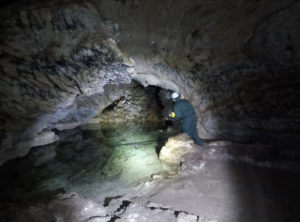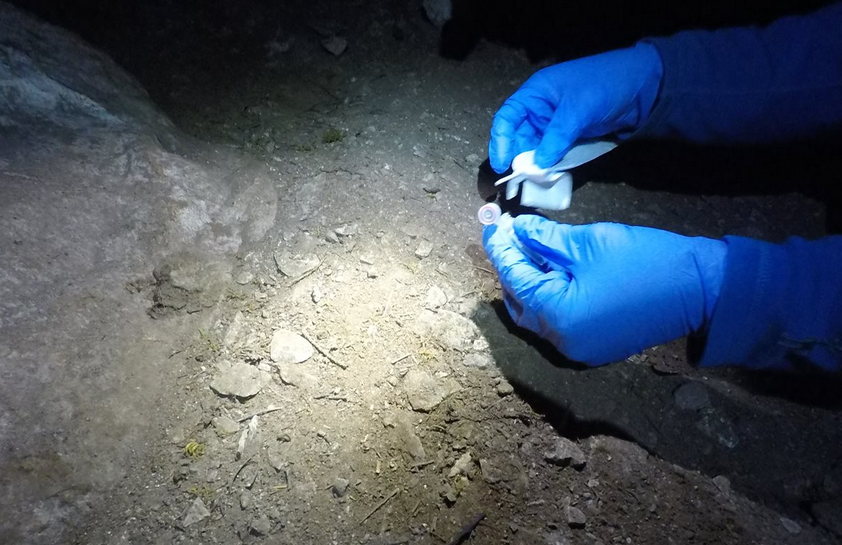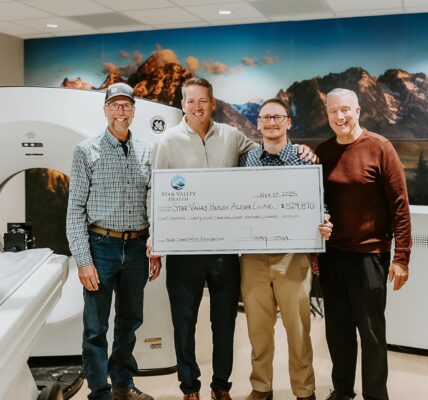 Game and Fish bat biologist Laura Beard and nongame technician Frank Stetler recently completed a bat hibernation survey in the Bighorn Mountains. In addition to recording the species and number of bats seen, samples were collected to look for evidence of white-nose syndrome.
Game and Fish bat biologist Laura Beard and nongame technician Frank Stetler recently completed a bat hibernation survey in the Bighorn Mountains. In addition to recording the species and number of bats seen, samples were collected to look for evidence of white-nose syndrome.
Bats with this disease are infected with a fungus that grows on their skin, appearing on the face and wings as white fuzz. While the growth of the fungus may not kill the bat outright, the irritation it causes often forces bats to wake during hibernation.
“They do normally arouse sometimes during hibernation, but white-nose syndrome causes a physiological cascade that makes them arouse more frequently,” said Beard. “This frequent arousal expends energy and without a supply of insects available in the winter, bats can starve or die from exposure when exiting the cave during winter conditions to search for food.”
The disease was discovered in New York in 2006 and has killed millions of bats in the east and Midwest and is expanding westward. To date, the disease has been found in 32 states and seven Canadian provinces. In June 2018, a little brown bat near Fort Laramie State Historic Site tested positive for Pseudogymnoascus destructans (Pd), the fungus which causes the disease, though it did not show outward signs of the disease.
Biologists with the Game and Fish Department have conducted hibernation surveys of bats for 25 years, but in recent years, have added testing for Pd to document if and when the disease arrives in our area.
“We have done hibernation surveys for a long time and we are monitoring the population that way,” said Beard. “While we don’t have a complete understanding of where our bats hibernate, these caves can be an indication of population trends. We are also looking for signs of the disease, such as any white fungal growth on the bats or any signs of mortalities inside or outside of the cave.”
Beard surveys several hibernacula each winter and tests two or three of these for Pd each year. Caves are on a rotational schedule, being surveyed not more than once every two to three years to minimize disturbance of hibernating bats. One cave in the Bighorn Mountains was on this year’s schedule, so on Jan. 15, Beard and Stetler traveled there to conduct tests.
The cave was accessed through private property after a 2.5 hour hike. Wearing protective coveralls and carrying multiple sources of lighting, the pair climbed through the entrance and began a survey of the cave’s 1,000 foot length. Walking slowly and scanning the ceiling, walls and crevices for bats, they recorded the number and species of bats seen.
In previous surveys, the cave has hosted as few as 10 hibernating bats (1995) and as many as 33 (2003). This year’s count was 31 individuals representing four species – big brown bat, little brown myotis, western small-footed myotis and the Townsend’s big-eared bat.
In addition to recording bat numbers and species, Beard collected 30 samples from the cave. Most samples consisted of soil substrate and bits of bat guano collected in small plastic tubes, but in a few cases, bats were hibernating low enough on walls to allow a swab to be gently rubbed on the exposed membrane of their forearms and muzzle. All of the samples were sent to the USGS National Wildlife Health Center where technicians will test them for Pd.
Upon exiting the cave, they followed a strict protocol for decontamination of all gear and items that entered the cave. Shoes, headlamps, coveralls, pencils, paper and other items were placed in a large plastic garbage bag that was carefully sealed and carried on the return hike. All the fabric items will be submerged, or ‘hot dipped’, in 140 degree Fahrenheit water for 20 minutes, before being used in another cave, to prevent potential contamination between caves. Items that cannot be submerged are wiped down with Lysol wipes containing ammonia that has been found to kill the fungal spores in laboratory testing. This decontamination procedure is outlined by the White Nose Syndrome Response Team and is recommended, or in some areas, required, for anyone who frequents caves.
The Wyoming Game and Fish Department was recently awarded $29,437 from the U.S. Fish and Wildlife Service to broaden white-nose monitoring and tracking of the little brown myotis bat to evaluate how they use their surroundings in the winter.






